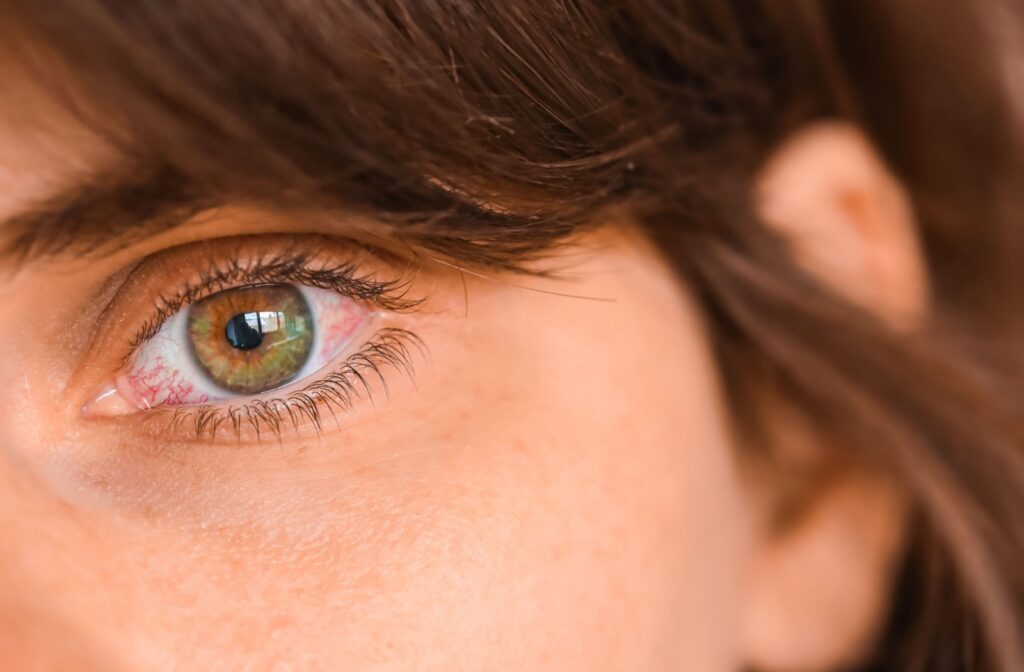Dry, gritty eyes can be more than just an annoyance. Many people struggle with dry eye without finding sufficient relief. If you’re among them, you know how disruptive dry, uncomfortable eyes can be to your daily comfort and productivity.
One treatment option for dry eye is low-level light therapy (LLLT). This newer light treatment is designed to target the meibomian glands. Dysfunctional meibomian glands are the cause of 80-86% of dry eye disease. If you suspect you may have dry eye, try our questionnaire or book a comprehensive eye exam.
What Is Low-Level Light Therapy?
While over-the-counter lubricating eye drops and warm compresses can help, LLLT is thought to target a key contributor to dry eye: the function and health of the meibomian glands. These glands are responsible for producing the outer oily layer of your tears, important for keeping your eyes lubricated.
LLLT harnesses visible and non-visible light wavelengths. While its use in dry eye treatment is relatively new, it’s designed to work by triggering photoactivation: light gets absorbed by the body’s cells, and stimulates mitochondria, the energy-producing powerhouse of the cell, to increase energy production and enhance various cellular processes. This light-induced stimulation triggers a cascade of biochemical reactions that can promote healing, reduce inflammation, and alleviate pain.
LLLT Procedure
Low-level light therapy is a relatively simple procedure. With their eyes closed, a patient sits back and relaxes under a mask-like device that produces the low-level light. The treatment should only last 15 to 30 minutes. Sessions are gentle and painless.. People can return to their regular activities immediately after a treatment session.
LLLT Benefits & Risks
This type of treatment has been used since the 1960s to treat skin conditions by reducing inflammation. It’s a relatively new treatment option for dry eye, but research suggests that it shows promising results.
LLLT is generally considered safe. Most patients experience no side effects. Occasionally, you may notice a mild warming sensation, temporary sensitivity to light, or slight ocular discomfort immediately after treatment. These effects are short-lived and typically resolve on their own.
The advantage of LLLT is that it can be used safely on areas more vulnerable to intense light, such as your eyelids.
More About Dry Eye & Meibomian Gland Dysfunction

Dry eye, an ocular surface disease, is a common condition in which you don’t produce enough tears or you produce unstable tears , leading to irritation and discomfort. Tear quality depends on the proper balance of water, oil, and mucus on the ocular surface.. Dry eye can have many causes, including aging, hormonal changes, medication side effects, autoimmune conditions, and environmental exposures (like wind, dry air, or prolonged screen use).
Symptoms of dry eye include:
- Red eyes
- A stinging sensation
- The feeling of something in your eye
- Excessive tears
Left untreated, severe dry eye can lead to more serious issues, such as scarring of the cornea, which impacts your vision. Dry eye can also make contact lenses more challenging to wear.
MGD: An Underlying Cause of Dry Eye
Your tears consist of three layers: an inner mucus layer, a middle water layer, and an oily outer layer. Your meibomian glands produce the outer layer of oil, called meibum. Meibomian gland dysfunction (MGD) happens when your meibomian glands don’t produce enough oil or the oil is of poor quality.
MGD is recognized as the most common cause of dry eye. Low-level light therapy is believed to be an effective treatment for dry eye as it works directly on the meibomian glands.
Other Treatments for Dry Eye
While LLLT offers a targeted and promising solution, it’s not the only path to finding relief. There are many other options, including:
- Thermal pulsation therapy: This is a warm massage of the eyelids, and it can help unclog blocked meibomian glands.
- Intense pulsed light (IPL) therapy: Pulses of light help melt blockages in the meibomian glands and also reduce inflammation, and pathogens in the eyelids.
- Radiofrequency treatment: RF uses gentle heat to open blocked meibomian glands and improve oil flow, helping to relieve dry eye symptoms.
- Warm compresses: This is a simple, first-line treatment of dry eye that you can try at home. Simply purchase an eye heat mask from your optometrist and wear it for 10 minutes, once or twice daily.
- Eye drops and ointments: Artificial tears bought over-the-counter and ointments, which are thicker, can help ease symptoms. Talk to your optometrist before trying a new treatment.
- Omega-3 supplements: Research suggests that omega-3 supplements can help with dry eye symptoms and tear production. Talk to your healthcare provider before trying a new supplement, as they can interact with other medications.
Dry Eye Treatment in St. Thomas
If you experience dry eyes that interfere with work, school, and everyday life, you’re not alone. An estimated 30% of Canadians experience dry eye symptoms.
Our clinic recognizes how much dry eye can impact your life, and we offer many treatment options, from eye drops and supplement recommendations to IPL, RF, LLLT, and thermal pulsation therapy (Lipiflow). To discuss your options for finding relief, book an appointment with us at First Optometry in St. Thomas today.



